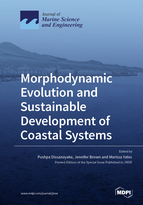Morphodynamic Evolution and Sustainable Development of Coastal Systems
A special issue of Journal of Marine Science and Engineering (ISSN 2077-1312). This special issue belongs to the section "Coastal Engineering".
Deadline for manuscript submissions: closed (10 July 2021) | Viewed by 28071
Please contact the guest editors or the journal editor (esme.wang@mdpi.com) for any queries.
Special Issue Editors
Interests: sediment transport; morphological changes; numerical modelling; coastal systems; climate change
Interests: modelling coastal hydrodynamics and morphodynamics; storm hazards; flood and erosion risk; climate change; coastal resilience
Special Issue Information
Dear Colleagues,
Coastal systems are unique environments that provide socioeconomic benefits. These functions are influenced by changing morphology, which results from erosion and sedimentation at different spatiotemporal scales, including both natural forcing and human interventions. Additionally, feedback between coastal processes and coastal engineering works leads to both positive and negative impacts. These dynamics are expected to continually change with flood and erosion hazards increasing in the future due to sea level rise, more frequent and severe storms, and acceleration of anthropogenic effects. Understanding the forcing factors, the natural morphodynamic evolution, and the response to potential scenarios will help coastal policy makers to set suitable adaptation strategies and to assure the sustainable use of coastal systems, which allows us to further enjoy numerous socioeconomic and environmental benefits. To capture the breadth of research, this Special Issue will cover a range of topics from process understanding to knowledge sharing and applications of new understanding. The common theme throughout the contributed papers will be the focus on coastal morphodynamics, including: sediment transport, morphological evolution, coastal erosion, storm impacts, influence of biota on morphology, impacts of coastal developments, natural and human-made future scenarios, and adaptation strategies. We invite papers related to these or similar topics.
Dr. Pushpa Dissanayake
Dr. Jenifer Brown
Dr. Marissa Yates
Guest Editors
Manuscript Submission Information
Manuscripts should be submitted online at www.mdpi.com by registering and logging in to this website. Once you are registered, click here to go to the submission form. Manuscripts can be submitted until the deadline. All submissions that pass pre-check are peer-reviewed. Accepted papers will be published continuously in the journal (as soon as accepted) and will be listed together on the special issue website. Research articles, review articles as well as short communications are invited. For planned papers, a title and short abstract (about 100 words) can be sent to the Editorial Office for announcement on this website.
Submitted manuscripts should not have been published previously, nor be under consideration for publication elsewhere (except conference proceedings papers). All manuscripts are thoroughly refereed through a single-blind peer-review process. A guide for authors and other relevant information for submission of manuscripts is available on the Instructions for Authors page. Journal of Marine Science and Engineering is an international peer-reviewed open access monthly journal published by MDPI.
Please visit the Instructions for Authors page before submitting a manuscript. The Article Processing Charge (APC) for publication in this open access journal is 2600 CHF (Swiss Francs). Submitted papers should be well formatted and use good English. Authors may use MDPI's English editing service prior to publication or during author revisions.
Keywords
- sediment transport
- coastal erosion
- morphological changes
- morphological processes
- extreme coastal impacts
- sea level rise
- anthropogenic effects
- adaptation strategies
- effects of biotic factors
- modelling








